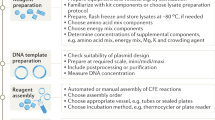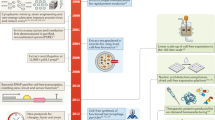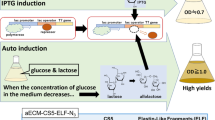Abstract
Cell-free systems represent a promising approach to quickly and easily produce preparative amounts of proteins. However, it is still challenging to obtain high volumetric yields (>mg ml−1) of proteins from the present cell-free systems. This protocol presents a cell-free protein synthesis method using a novel DNA gel that dramatically increases protein yield compared with current systems. This protein-producing gel (termed 'P-gel system' or 'P-gel'), which consists of genes as part of the gel scaffolding, can produce mg ml−1 amounts of functional proteins. This protocol describes steps pertaining to plasmid design, fabrication of P-gel molds, formation of P-gel micropads and cell-free protein expression with an expected yield of up to 5 mg ml−1 of functional Renilla luciferase (Rluc). This entire process can take 1–3 d, depending on the desired quantity of protein.
This is a preview of subscription content, access via your institution
Access options
Subscribe to this journal
Receive 12 print issues and online access
$259.00 per year
only $21.58 per issue
Buy this article
- Purchase on Springer Link
- Instant access to full article PDF
Prices may be subject to local taxes which are calculated during checkout









Similar content being viewed by others
References
Jermutus, L., Ryabova, L.A. & Pluckthun, A. Recent advances in producing and selecting functional proteins by using cell-free translation. Curr. Opin. Biotechnol. 9, 534–548 (1998).
Xu, Z.N., Chen, H.Q., Yin, X.F., Xu, N.Z. & Cen, P.L. High-level expression of soluble human beta-defensin-2 fused with green fluorescent protein in Escherichia coli cell-free system. Appl. Biochem. Biotechnol. 127, 53–62 (2005).
Spirin, A.S. & Swartz, J.R. Cell-free protein synthesis, 69–82 (WILEY-VCH Verlag GmbH & Co., Weinheim, 2008).
DeVries, J.K. & Zubay, G. DNA-directed peptide synthesis. II. The synthesis of the alpha-fragment of the enzyme beta-galactosidase. Proc. Natl. Acad. Sci. USA 57, 1010–1012 (1967).
Spirin, A.S., Baranov, V.I., Ryabova, L.A., Ovodov, S.Y. & Alakhov, Y.B. A continuous cell-free translation system capable of producing polypeptides in high-yield. Science 242, 1162–1164 (1988).
Kim, D.M. & Swartz, J.R. Prolonging cell-free protein synthesis with a novel ATP regeneration system. Biotech. Bioeng. 66, 180–188 (1999).
Kim, D.M. & Swartz, J.R. Regeneration of adenosine triphosphate from glycolytic intermediates for cell-free protein synthesis. Biotech. Bioeng. 74, 309–316 (2001).
Ghosh, D. et al. Transcription of T7 DNA immobilised on latex beads and Langmuir–Blodgett film. J. Biochem. Biophys. Methods 62, 51–62 (2005).
Calhoun, K.A. & Swartz, J.R. Total amino acid stabilization during cell-free protein synthesis reactions. J. Biotech. 123, 193–203 (2006).
Um, S.H. et al. Enzyme-catalysed assembly of DNA hydrogel. Nat. Mater. 5, 797–801 (2006).
Park, N., Um, S.H., Funabashi, H., Xu, J. & Luo, D. A cell-free protein-producing gel. Nat. Mater. 8, 432–437 (2009).
Seeman, N.C. DNA in a material world. Nature 421, 427–431 (2003).
Feldkamp, U. & Niemeyer, C.M. Rational design of DNA nanoarchitectures. Angew. Chem. Int. Ed. 45, 1856–1876 (2006).
Nam, J.M., Thaxton, C.S. & Mirkin, C.A. Nanoparticle-based bio-bar codes for the ultrasensitive detection of proteins. Science 301, 1884–1886 (2003).
Lee, J.B. et al. Multifunctional nanoarchitectures from DNA-based ABC monomers. Nat. Nanotechnol. 4, 430–436 (2009).
Li, Y.G. et al. Controlled assembly of dendrimer-like DNA. Nat. Mater. 3, 38–42 (2004).
Um, S.H., Lee, J.B., Kwon, S.Y., Li, Y. & Luo, D. Dendrimer-like DNA-based fluorescence nanobarcodes. Nat. Protoc. 1, 995–1000 (2006).
Li, Y.G., Cu, Y.T.H. & Luo, D. Multiplexed detection of pathogen DNA with DNA-based fluorescence nanobarcodes. Nat. Biotechnol. 23, 885–889 (2005).
Acknowledgements
The work is partially supported by a NYSTAR Faculty Development Program Award, NYSTAR CAT grant, US National Science Foundation's CAREER award (grant number: 0547330) and a USDA NRI grant. We acknowledge the use of the facilities of the Cornell Centre for Materials Research, which is supported through NSF Grant DMR 0520404, part of the NSF MRSEC Program.
Author information
Authors and Affiliations
Contributions
N.P., S.H.U., H.F., J.X. and D.L. developed the original technique. N.P., J.S.K., E.J.R., M.R.H. and D.L. organized the procedure and cowrote the manuscript.
Corresponding author
Rights and permissions
About this article
Cite this article
Park, N., Kahn, J., Rice, E. et al. High-yield cell-free protein production from P-gel. Nat Protoc 4, 1759–1770 (2009). https://doi.org/10.1038/nprot.2009.174
Published:
Issue Date:
DOI: https://doi.org/10.1038/nprot.2009.174
This article is cited by
-
Hydrogels as functional components in artificial cell systems
Nature Reviews Chemistry (2022)
-
Hybrid material of structural DNA with inorganic compound: synthesis, applications, and perspective
Nano Convergence (2020)
-
Enzyme-based fabrication of physical DNA hydrogels: new materials and applications
Polymer Journal (2020)
-
Tailoring DNA Self-assembly to Build Hydrogels
Topics in Current Chemistry (2020)
-
Multifunctional nucleic acid nanostructures for gene therapies
Nano Research (2018)
Comments
By submitting a comment you agree to abide by our Terms and Community Guidelines. If you find something abusive or that does not comply with our terms or guidelines please flag it as inappropriate.



